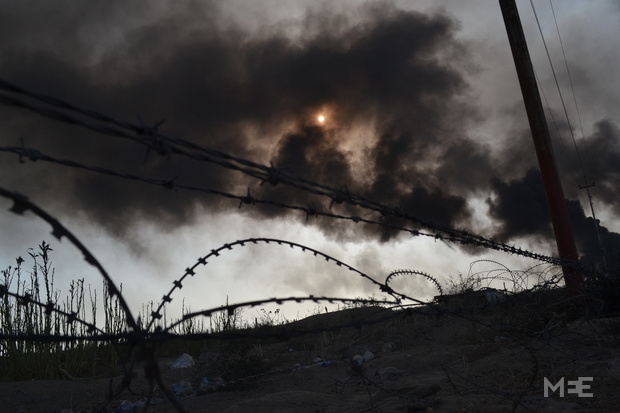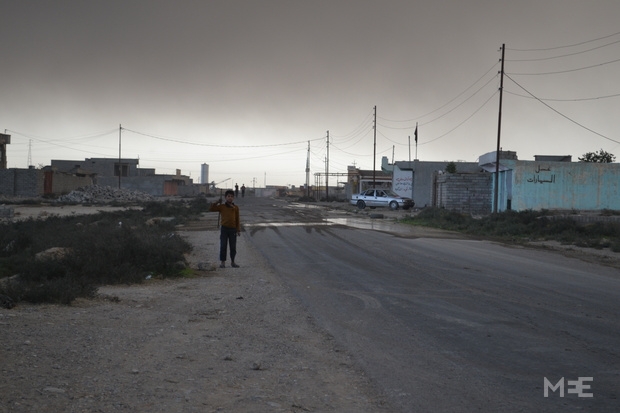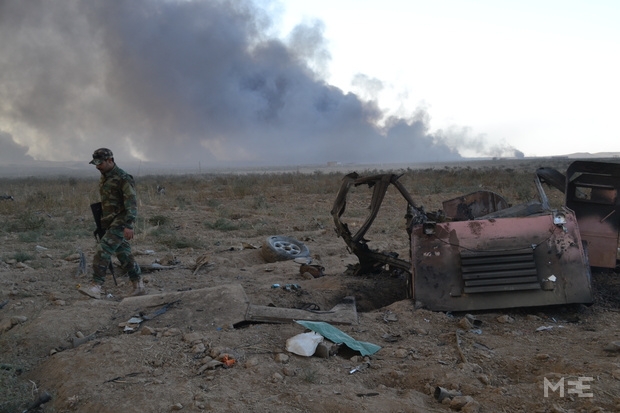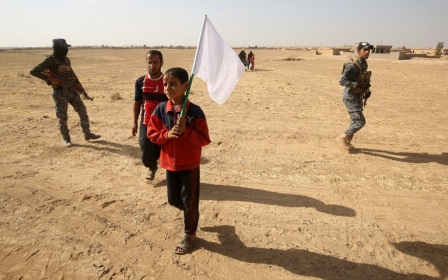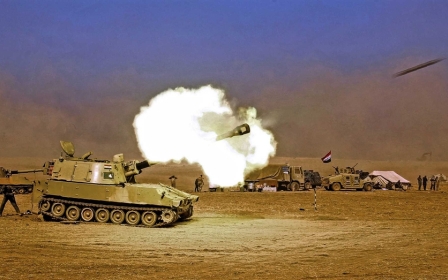Apocalypse now: Iraqis choke as oil fields lit by IS are visible from space

QAYYARAH, Iraq - When Islamic State militants were chased out of the small Sunni town of Qayyarah, the town’s 13,000 or so remaining residents were praised by the Iraqi government for staying put during the fighting.
By not fleeing the Islamic State’s occupation, they did not add to the growing population displacement crisis in Iraq, and they also showed steely determination to withstand the brutality of the most hated terror group in the world.
But if marauding militants were not enough to force the largely Sunni town to flee, it appears the toxic pollution created by IS’s masochistic violence just might be.
On leaving the town, the groups few remaining militants set fire to the nearby oil fields. The fields are small, particularly compared to others in Iraq, producing around 10,000 barrels of heavy, sulphurous oil per day, according to Patrick Osgood of the Iraq Oil Report.
Primarily retained for domestic use, the oil field was an important employer, giving jobs to hundreds of the town’s residents, and with thousands more financially dependent on their relatives employment in the industry.
According to Osgood, an estimated $150,000 worth of oil is being burned each day, in just one oil field, ejecting a thick plume of black smoke that gives the whole town an apocalyptic feel.
They also serve as a scar, a reminder that the Islamic State group is still a threat. Indeed as you wander around the town, machine gun fire is plainly audible and the ash-black carcasses of car bombs are everywhere. The Iraqi army’s frontlines are just a few hundred metres outside the town’s perimeter.
One man, a resident of the town, who gave his name as Ahmed, explains why he had stayed through it all. “When they came to Qayyarah, they would execute people in the street. They killed my brother. I stayed through all of that because this is my home. The Islamic State will not last forever and I knew we must stay to rebuild Qayyarah, to rebuild Iraq, so that it is standing long after Daesh (IS) are exterminated. It was my responsibility.”
Despite his stoicism, however, now even he is considering leaving. “Every morning I wake up and I feel ill. I can’t stop coughing. IS didn’t kill me, but I’m fearful that the fumes might.”
Liberated but toxic
Ahmed is not alone. Several hundred of the town’s residents have been hospitalised for respiratory problems as a result of the plumes, and at least 30 deaths have been reported.
Qayyarah now finds itself in a situation where, despite being liberated, its remaining residents are beginning to flee. They fear that the toxic smoke might achieve what the Islamic State group were unable to do.
Medical clinics in the area are reopening, but they lack the resources to deal with the effects of smoke inhalation – notably bottled oxygen - and they tend to prioritise combat wounds instead.
One person to have already fled the plumes of smoke is Muna. She returned to her home in Qayyarah briefly following the town’s liberation. But after two days she returned to a makeshift camp on the outskirts of Erbil. “There is nothing for me to go back to,” she said. “My husband is gone and I can’t live a simple life there. I will not raise my children amid the poison."
She elaborates saying, "Even under Daesh we could try to stay out of trouble. We would stay indoors and pray when they told us to pray, but you cannot hide from the smoke," she added. “When I returned I was coughing all the time, the doctors there could do nothing, they couldn’t help me. I had to help myself.”
Although official measurements have yet to be taken, Timothy Atkin, a consultant geologist, suggests that the levels are almost certainly above US-proscribed pollutant limits, adding that “at these sorts of levels the pollutants, which initially cause mainly coughing and headaches, can be immediately dangerous to life”.
There are no signs of the situation improving. Following the routing of his army from Kuwait in the first Gulf war, Saddam Hussein set fire to some of the country’s largest oil wells. The largest of those burned for more than 10 months, and they were only put out following the efforts of specialist teams from the United States.
However, there is no sign that similar efforts are being made to extinguish the fires in Qayyarah or elsewhere. As Osgood of Iraq Oil Report says: “Rocket and mortar attacks continue in the area, so the security situation prevents the close-quarters fire fighting needed to pump enough water at the wellheads.”
In the days before MEE's visit, at least three cars laden with explosives blew up in the town. Fortunately, they were brought to a halt outside the city but the threat is still very real. Even if the safety situation was to finally be brought under some semblance of control, authorities still lack the capability to tackle the blazes.
Osgood explains: “The North Oil Company likely lacks the equipment to tackle a severe fire of this size. There are probably not many who can. The Iraqi government has claimed to have made progress putting out fires, but the reality is all the wells [that were] lit, remain lit. Meanwhile Iraq is lobbying the US for assistance, but no contractor is going to put men on the ground when they might take fire or be killed by another explosion. So until the area is secure, the fires will leak and burn, perhaps for many more weeks to come.”
Smoke seen from space
The issue has become even more lethal in recent days. Retreating IS militants torched at least part of the nearby Mishraq Sulphur plant, one of the largest such factories in the region. Noxious sulphur dioxide and hydrogen sulphide are now also being released into the air in plumes visible from the International Space Station. Local authorities claim that at least two people have been killed, and more than 30 hospitalised.
Shifting winds have sent the fumes towards the nearby Qayyarah airbase, where hundreds of US military personnel have been forced to operate in gas masks.
The Iraqi army too has provided some of their nearby personnel with respirators, but the reality is that it is local residents who are most at risk. Few have gas masks or realise the danger the fumes pose.
A sudden change in wind direction also poses serious risks to the operation to take back Mosul. Nearby frontlines to the east of Mosul are mainly manned by Kurdish Peshmerga forces, very few of whom have the equipment to protect themselves against, and operate in the toxic smoke.
Acid rain threat
Both forms of pollution - the thick black smoke from the burning oil and the chemical output from the sulphur plant, also present serious risks to Iraq’s environment in the long term.
As Timothy Atkin warns, “when sulphur dioxide is mixed with water it can form sulphuric acid, which once in the atmosphere can cause acid rain,” and with Iraq’s winter - a period during which approximately 90 percent of the country’s annual rainfall comes down - fast approaching, the risk is deadly and growing.
But the risk extends beyond simply adverse health effects. Acid rain is likely to kill much of the vegetation in the areas it falls on, whilst a lack of sunlight courtesy of the oil plumes poses similar risks to both vegetation and residents.
Qayyarah may have been liberated from the Islamic State group, but it is clear the biggest threats to its residents and authorities are yet to come. It is perhaps symptomatic of the sort of challenges a post-IS Iraq will face.
This article is available in French on Middle East Eye French edition.
New MEE newsletter: Jerusalem Dispatch
Sign up to get the latest insights and analysis on Israel-Palestine, alongside Turkey Unpacked and other MEE newsletters
Middle East Eye delivers independent and unrivalled coverage and analysis of the Middle East, North Africa and beyond. To learn more about republishing this content and the associated fees, please fill out this form. More about MEE can be found here.


